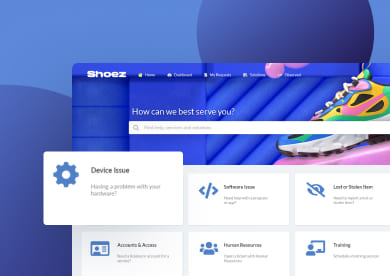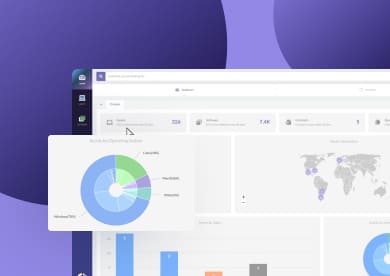Through the lens of Global Business Services (GBS), organizations are rethinking the way they operate by consolidating all their internal functions under a unified model. The objective isn’t just operational alignment but building the conditions for faster decision-making, deeper visibility, and cross-functional efficiency.
The concept itself isn’t entirely new. Shared services laid the groundwork. Enterprise Service Management (ESM) offered a supporting framework. GBS builds on both, combining process integration with governance, automation, and measurable outcomes.
Still, the model can be difficult to pin down in practice. That’s what we’ll unpack here: the definition, how it compares to related approaches, its measurable benefits, and how you can introduce it into your organization.
What are global business services?
Global business services, or GBS, is an operational model that brings together multiple business support functions — such as IT, HR, finance, legal, and procurement — into a unified structure. Instead of running these functions separately within different regions or departments, GBS creates an integrated setup designed to operate at scale, with shared governance and service delivery standards.
The goal is to improve consistency, efficiency, and visibility across internal services. For example, instead of separate ticketing systems or processes for IT and HR, GBS seeks to centralize requests, reduce redundancies, and create a more cohesive experience for both employees and service owners.
What distinguishes GBS from its predecessors is its scope. It isn’t only about cost savings—it’s also about how services are consumed, measured, and improved at scale. Leading GBS organizations treat internal functions as service providers that compete on quality, efficiency, and customer satisfaction.
GBS vs. shared services vs. ESM
These three concepts often appear together in discussions about operational efficiency, but they serve different purposes.
Shared services consolidate transactional activities within a single function — for instance, a centralized HR team managing payroll across the company. It’s typically the first step toward unifying back-office operations.
Global Business Services (GBS) takes a broader view. It integrates multiple functions — like IT, finance, HR, procurement, and legal — under a single governance model. The focus shifts from function-specific consolidation to enterprise-wide service delivery, often with shared goals, performance metrics, and customer experience standards.
Enterprise Service Management (ESM) complements both models. While often associated with technology platforms, ESM also represents a service-oriented mindset applied across the business. It provides the processes, workflows, and automation to enable consistent service delivery across departments. ESM frameworks help standardize how services are requested, delivered, and measured — whether in a shared services model or a fully integrated GBS environment.
GBS benefits
The rationale for adopting GBS isn’t abstract. It produces tangible outcomes when executed correctly. According to the 2025 Deloitte Global Business Services Survey:
- 55% of organizations with a global GBS leader have achieved over 20% in average cost savings.
- GBS organizations are prioritizing customer experience to drive loyalty and differentiation.
- Strategic direction from global GBS leaders improves decision-making and cross-functional alignment.
GBS is also the answer to a pressing need for all businesses: to do more with less. The Hackett Group projects that workload will grow by 11% in 2025, while budgets will only increase by 7%. The gap is being addressed through technology investments, including GenAI tools that support both efficiency and innovation.
Where GBS models mature, organizations often report:
- Faster issue resolution thanks to centralized case and knowledge management.
- Improved visibility and reporting, leading to better compliance and audit readiness.
- A more consistent service experience for employees, regardless of the department they interact with.
- Scalable operations that support regional, functional, or global needs.
How to implement global business services into your organization
Adopting a GBS model isn’t something you roll out in one step. It involves rethinking internal structures and redesigning processes. Here's a structured approach:
- Appoint cross-functional leadership – Start with clarity around who owns the initiative. Global GBS leaders help set the strategic direction, while functional and regional leaders can stay focused on operational performance and service quality.
- Define the scope – Decide which functions will be included initially. IT, HR, and procurement often make good starting points due to their interdependent workflows.
- Standardize processes – Identify core processes across functions and look for opportunities to standardize and consolidate. That sets the foundation for automation and shared services.
- Use metrics and feedback – Monitor service quality, cycle times, and satisfaction scores. GBS works best when it's treated as a performance-driven model, not just an organizational change.
There’s a final step that will support all the previous ones: invest in enabling technology.
A GBS model can’t function without a platform to support it. That’s where Enterprise Service Management (ESM) software comes in. Tools like InvGate Service Management provide the structure and visibility into the service lifecycle needed to manage them at scale, unify operations across departments, and generate meaningful operational data.
With ESM software, organizations can boost their strategy with:
- Cross-functional workflows - For example, onboarding a new employee might involve HR, IT, and Legal, all coordinated within a single request.
- Automation and real-time visibility that reduce manual tracking and expose delays or bottlenecks early.
- Unified service portals so employees can access support from any department through a single, consistent interface.
- Centralized case management, compliance tracking, and audit-ready reporting that simplify oversight.
- Dashboards and performance metrics that show how services are performing against business goals and give leaders a clear view of volumes, resolution times, SLA compliance, and customer satisfaction.
To sum up
Global business services is not a short-term fix or a rebranding of shared services. It’s a deliberate move toward operational alignment across functions, designed to reduce inefficiencies and improve internal service experiences. Tools like Enterprise Service Management systems support that vision by enabling cross-functional workflows, automation, and user-facing portals.
If your organization is looking to scale while improving visibility and user satisfaction, implementing a GBS model backed by the right technology can help achieve that. The results, as reported by GBS leaders globally, are measurable — both in savings and in service improvements.















